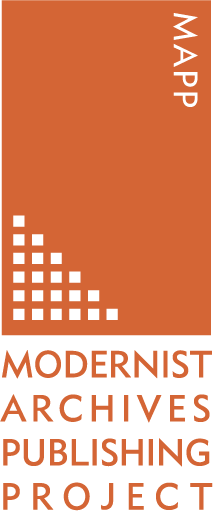We were recently excited to learn that Harvard University has put online one complete volume of the six photographic family albums of Virginia Woolf now housed at Harvard’s Houghton Library. This beautifully ‘flippable’ complete album was blogged about on Open Culture; you can view it in full here.
Harvard uses Mirador, a viewfinder that allows for page flip functionality. In Phase Two of MAPP, we hope to adopt a similar operability so viewers will be able to page through a complete production folder for a Hogarth Press book, for instance; or, in the longer term, read the Order Books as if in situ. Mirador’s interface gives readers the intimate impression of sitting in the archive, turning the pages of the single photograph album, as they gaze at each full page. They can take in the recto-verso construction of the album and imagine Woolf arranging the photographic juxtapositions. It is touching—though our fingers don’t physically handle the pages—to see the incisions Woolf must have cut into the album to hold each print, and then, upon ‘turning’ the page, to see the pointed triangular edges poking out of the verso. Presence and obsolescence powerfully intermingle in such a manipulation of the view. The pixilation is so fine that we can trace the pencil outlines Woolf made to position each image. These fine-grained visual details, enhanced by Mirador’s zoom capabilities and the high digital resolution that the library invested in, extenuate and texturize the digital reading experience; they adumbrate extant print reproductions of sample album pages such as those in Maggie Humm’s beautifully produced 2006 book, Snapshots of Bloomsbury: The Private Lives of Virginia Woolf and Vanessa Bell, which draws on this archive.
With Humm’s book, alongside Harvard’s online descriptive catalogue of all six albums including the names of people in all the images, it was possible, before this Mirador album, to get a strong sense of Woolf’s photograph collection. However, nothing quite replicates full archival access to the albums themselves, and one anomaly helped remind me just why archival cross-referencing is so valuable.
As I flicked—or perhaps we should refer to the digitally onomatopoeic ‘clicked’—through the pages, I was struck by one image I had seen many times in other contexts, but usually with the third figure cropped out. It’s this image of Lytton Strachey and Virginia Woolf sitting close together on a bench, formally dressed, with a third bespeckled and hatted older man sitting at a slight remove. He’s cropped out in other contexts presumably because he’s less famous. It was this memory (conjured or real?) that made me look more closely at Woolf’s caption. This man, apparently, is Yeats. At least her script says Yeats. But the caption in the online catalogue names him as the Cambridge philosopher and political scientist, Goldsworthy Lowes Dickinson, which Humm’s printed caption replicates in her reproduction of the whole album page. A quick Google image search has me intrigued: could this have been Yeats? Why did Woolf remember it as being Yeats if it was Lowes Dickinson? Did the men look similar? Both wore spectacles, it appears, but did one prefer hats over another? But mainly, I wondered, who changed the label from her holographic one (“Yeats”) to a typographic one (“Goldsworthy Lowes Dickinson”), which was then replicated in subsequent print and digital reproductions? Reading and seeing in this case are perhaps two different things.
The photograph was taken by Ottoline Morrell, whose own album images appear to be held by the National Portrait Gallery. In others of those, she captions a photograph of a man at one of her garden parties as G. Lowes Dickinson, and it does seem, from his attire, that this is the same man at the same party where he sat on a bench, at a remove, next to Woolf and Strachey. So, perhaps it is this evidence that drives the editorial or archivist’s label. It is an intervention which is also an overwriting. But to see the album page itself, we are at least brought back to Woolf’s (mis?)remembering. That is the most interesting point; perhaps Yeats was at this same party (there are other images of him at other Morrell parties), and perhaps this misattribution, while ghosting ‘Goldie’, captures a lost Yeatsian connection between Woolf and the great modernist poet she cherished in her memory. We might never know. But the archive, as always, can keep us guessing.




